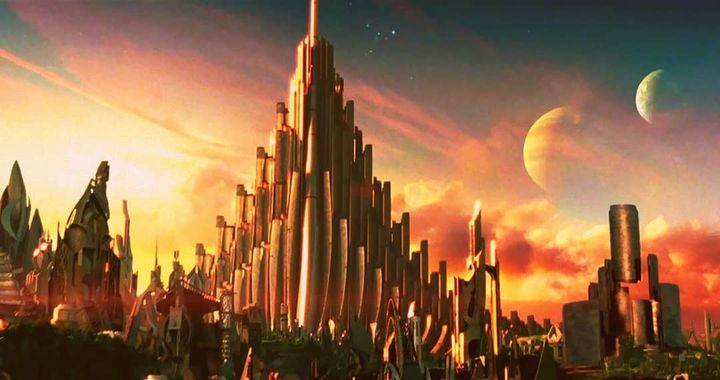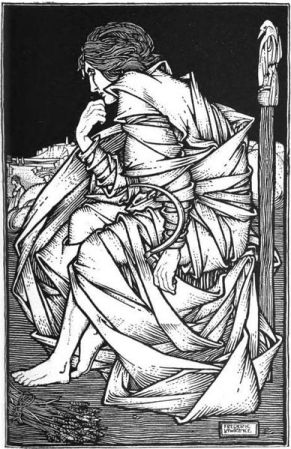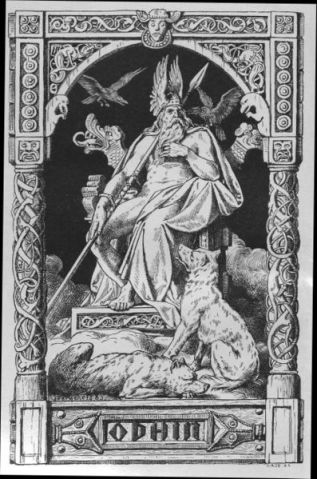Among the numerous mythical elements surrounding Odin the Allfather, two prominent aspects are his throne Hlidskjalf (Old Norse Hliðskjálf) and its placement in the great hall of Valaskjalf (Old Norse Valaskjálf). Here I am going to dive into both actual mentions of the two and try to explore how they should be understood in a broader sense.
Hlidskjalf: The Throne of Odin
Hlidskjalf is the majestic throne of Odin, located in the hall of Valaskjalf. The throne is said to be constructed of silver and adorned with intricate designs, featuring symbols that represent Odin’s wisdom and power. These decorations symbolize Odin and his connection to the afterlife, as well as depictions of ravens, wolves, and other animals associated with the Allfather.
One of the defining attributes of Hlidskjalf is its power to grant the one who sits upon it the ability to see everything that occurs in the nine realms. This all-seeing power allows Odin to maintain order, provide guidance, and make informed decisions.
Hlidskjalf plays a crucial role in Odin’s decision-making process, as it allows him to access knowledge and information otherwise unavailable to him. The throne’s associations with wisdom and foresight are central to Odin’s role as the Allfather. Moreover, it goes hand in hand with his continued quest for knowledge.
Valaskjalf: The Hall of the Slain

Valaskjalf is a magnificent hall situated in Asgard, the realm of the gods. It lies in close proximity to Valhalla, the glorious hall where fallen warriors are brought by the Valkyries after dying. Valaskjalf’s location enables it to serve as a focal point for the gods and allows them to oversee the goings-on in other realms.
Valaskjalf is described as a vast and imposing structure, built with the finest materials available in the nine realms. It is roofed with shimmering silver. Inside the hall, Odin has his throne and there the gods meet to discuss matters of great importance.
The hall of Valaskjalf serves multiple purposes in Norse mythology. Firstly, it functions as Odin’s observation post into the other realms. Secondly, it plays a pivotal role in strategizing and planning for the impending doom of Ragnarok, the great battle that will determine the fate of the gods and the cosmos. In this sense, Valaskjalf represents the divine realm’s connection to the afterlife and the broader responsibilities of the gods in maintaining cosmic balance.
Important Tales and Legends Involving Hlidskjalf
Odin’s insatiable thirst for knowledge is a recurring theme in Norse mythology. In his quest for wisdom, he makes significant personal sacrifices. One such example is when he trades his eye for a drink from the Well of Mimir, which bestows immeasurable knowledge upon him. In another instance, Odin hangs himself from the world tree, Yggdrasil, for nine days and nights to obtain the secret of the runes. Sitting on the throne Hlidskjalf, he employs this wisdom and insight to govern the gods and protect the cosmos.
Freyr’s seeing Gerdr from Hlidskjalf in Skirnismal
The story of Freyr and Gerdr highlights the consequences of misusing the power of Hlidskjalf. One day, Freyr, the god of fertility and prosperity, sits on Hlidskjalf and gazes across the realms deep into Jotunheim. There he spies the beautiful giantess Gerdr and soon becomes infatuated with her.

Exactly how Freyr came to be sitting on Odin’s throne is lost to us and possibly something we will never know. This act however leads to a series of events that culminate in a complicated and difficult courtship between Freyr and Gerdr, demonstrating the potential dangers of misusing the throne’s powers.
The story of Grimnismal
The tale of Grimnismal showcases the significance of Hlidskjalf in the relationship between Odin and his wife, Frigga. In this story, the two gods engage in a wager, and Odin disguises himself as Grimnir to visit King Geirrod. While at King Geirrod’s, Odin is subjected to torture, but he continues to impart wisdom to Geirrod’s son, Agnar.
When Odin reveals his true identity, the king inadvertently kills himself in an attempt to free the disguised god. This tale highlights the role of Hlidskjalf as a place where Odin and Frigga exercise their divine powers and wisdom. In that way they are influencing the lives of mortals and shaping the destiny of the cosmos.
Symbolism and Interpretations
Hlidskjalf embodies Odin’s authority as the Allfather and his immense wisdom. The throne represents the ultimate source of divine knowledge and the power to shape the fate of the cosmos. It also symbolizes the responsibility that comes with such power, as Odin must use his wisdom and any knowledge gained from the throne to further his plans.
Valaskjalf (translates to Shelf of the Slain) serves as a representation of the divine realm and the afterlife in Norse mythology. As a gathering place for gods and fallen warriors, it highlights the connection between both the divine and the mortal worlds.
Hlidskjalf and Valaskjalf, as symbols of authority and wisdom, emphasize the importance of using knowledge and power responsibly. Odin, as the Allfather, must wield his immense wisdom for the greater good, preparing for the doom of Ragnarok.
Mentions of Hlidskjalf and Valaskjalf in ancient texts
Please note that translations may vary, and the specific stanzas or passages may not always use these terms explicitly.
Poetic Edda
Grímnismál (The Lay of Grímnir) stanza 6:
In this stanza, Odin (as Grímnir) mentions Valaskjalf and its shining roof.
6. There is a third home | were gentle gods
Roofed the hall with silver
Valaskjálf it is called, | built in ancient times
Built by a god for himself.
Skírnismál (The Lay of Skírnir) Prose introduction:
In the introduction to this fun and rather graphic poem, we learn how Freyr could see into all of the different worlds when sitting in Hlidskjalf.
“Freyr, son of Njord, was sitting one day in Hlidskjalf and looked over all the worlds. He looked into Jotunheim and saw a beautiful maiden leaving her father’s house.”
Prose Edda
Gylfaginning (The Beguiling of Gylfi) – Chapter 7:
In this chapter, Snorri Sturluson describes Valaskjalf and Hlidskjalf as part of the description of Asgard and its halls.
“And there is a great dwelling called Valaskjalf, which belongs to Odin. The gods made it and thatched it with, sheer silver. In this hall is the high-seat, which is called Hlidskjalf, and when Alfather sits in this seat, he sees over all the world.”
Gylfaginning (The Beguiling of Gylfi) – Chapter 11:
Snorri Sturluson mentions that one day, Freyr sat on Hlidskjalf and looked over all the worlds. This is when he saw Gerdr, the giantess he would later fall in love with.
“One day when Freyr had gone into Hlidskjalf, and was looking out upon all the worlds, he saw toward the north a hamlet wherein was a large and beautiful house.”
Gylfaginning (The Beguiling of Gylfi) – Chapter 15:
This chapter is about the death of Baldur and how the gods set out to capture and punish Loki for his actions. Loki had gone into hiding however, so Odin used Hlidskjalf to find him.
“Then he saw that the Aesir were not far distant. Odin had seen from Hlidskjalf where Loke kept himself. Loke immediately sprang up, cast the net on the fire and leaped into the river.”
Skáldskaparmál (The Language of Poetry) – Chapter 2:
In this chapter, Snorri Sturluson refers to Valaskjalf when discussing the origin of kennings for Odin.
“Thórálfr sang this:
The Mighty One of Hlidskjálf
Spoke his mind unto them
Where the armys of fearless
Hárekr were slaughtered.”
FAQs
Hlidskjalf is the high and mighty throne of Odin, the Allfather and chief of the Norse gods. From this throne, Odin can observe all the nine realms of the Norse cosmos, granting him unparalleled wisdom and knowledge.
Valaskjalf is one of the great halls in Asgard, the realm of the gods in Norse mythology. It is the location of Odin’s throne, Hlidskjalf. Valaskjalf is said to have a shining roof made of silver, reflecting its divine nature and importance.
Traditionally, only Odin and his wife Frigga are allowed to sit on Hlidskjalf. However, there are instances in Norse mythology where other gods, such as Freyr, have sat on the throne, leading to significant consequences.
Hlidskjalf grants its occupant the ability to see and observe all the nine realms in Norse mythology. This all-seeing power provides immense wisdom and insight, which Odin uses to govern the gods and maintain cosmic order.
There are several tales involving Hlidskjalf, such as the story of Grimnismal, where Odin and Frigga use the throne’s powers to engage in a wager. Another story is Skirnismal, about the story of Freyr and Gerdr, where Freyr’s misuse of Hlidskjalf leads to a complicated courtship with the giantess Gerdr.
Featured Image Credit: Lorenz Frølich, Public domain, via Wikimedia Commons

